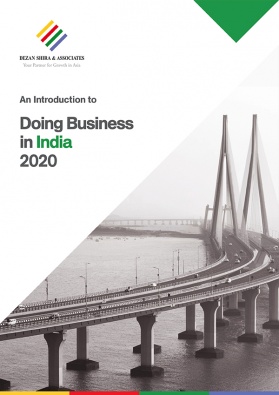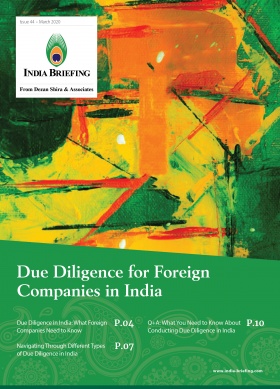India Extends Manufacturing Incentive Scheme for 10 Sectors
India approved the extension of its Production-Linked Incentive (PLI) Scheme for 10 flagship sectors on Wednesday, November 11, with an outlay worth INR 1.46 trillion (US$19.54 billion).
The PLI scheme already benefits three major industries – mobile manufacturing and electric components, pharmaceutical (critical key starting materials/active pharmaceutical ingredients), and medical device manufacturing.
Announcement of the PLI schemes was followed by news of another stimulus package worth INR 1.19 trillion (US$15.93 billion), which will include a scheme “to boost re-employment chances of formal sector employees who lost their jobs during the COVID-19 pandemic”. Previously, in October, the government had announced its Consolidated FDI Policy, 2020 to clear up confusion regarding investment regulations in respective sectors.
Collectively, these signal efforts from the top to rejig production activity in the country, create new jobs, improve liquidity through investment liberalization, and advance key industries through preferential treatment. In particular, the PLI schemes want to make Indian manufacturing globally competitive, attract greater foreign investment in areas of core competency and cutting edge technology, and engineer export-led growth.
Finance Minister Nirmala Sitharaman explained that through the PLI “…we want to build our strength but yet link with the global value chains.” What that essentially translates to is that India urgently needs manufacturing investment to be able to participate more meaningfully in upstream industries and be a part of global supply chains.
Meanwhile, on November 12, during a virtual summit between India and ASEAN, the Indian Prime Minister Narendra Modi said, “Enhancing every type of connectivity between India and ASEAN – physical, economic, social, digital, financial, maritime – is a major priority for us. In the last few years, we have come close to all these areas.” Given India’s refusal to join the Regional Comprehensive Economic Partnership (RCEP) trade agreement, the overture indicates India’s serious intent to improve bilateral ties with the regional grouping, possibly to offset the market dependency on China amid rising political tensions. (15 members agreed to sign the long-awaited trade deal on Wednesday, including the 10 ASEAN members and Japan, China, South Korea, Australia, and New Zealand. The RCEP members, however, have left the door open for India to join later. RCEP will cover 30 percent of the global GDP and trade.)
Which sectors will benefit from production-linked incentives?
The following sectors will benefit from the production-linked incentive (PLI) scheme, which seeks to enhance India’s manufacturing capabilities and boost exports.
They include sunrise sectors, labor-intensive sectors, and those sectors where India wants to develop links to the global value chain.
Advance chemistry cell (ACC) battery
- Implementing ministry/department: NITI Ayog and Department of Heavy Industries
- Sector-wise product lines: ACC batteries
Electronics and technology
- Implementing ministry/department: Ministry of Electronics and Information Technology
- Sector-wise product lines: Semiconductor fab, display fab, laptops and notebooks, servers, Internet of Things (IoT) devices, specified computer hardware
Automobiles and auto components
- Implementing ministry/department: Department of Heavy Industries
- Sector-wise product lines: Automobiles and auto components
Pharmaceutical drugs
- Implementing ministry/department: Department of Pharmaceuticals
- Sector-wise product lines:
Category 1 – biopharmaceuticals, complex generic drugs, patented drugs or drugs nearing patent expiry, cell-based or gene therapy products, orphan drugs, special empty capsules, complex excipients.
Category 2 – active pharmaceutical ingredients (APIs)/ key starting materials (KSMs), and drug intermediaries (DIs).
Category 3 – i) repurposed drugs; ii) auto-immune drugs, anti-cancer drugs, anti-infective drugs, cardiovascular drugs, psychotropic drugs, and anti-retroviral drugs; iii) in-vitro diagnostic devices (IVDs); iv) Phytopharmaceuticals; v) Other drugs not manufactured in India; vi) Other drugs as approved
Telecom and networking products
- Implementing ministry/department: Department of Telecom
- Sector-wise product lines: Core transmission equipment, 4G/5G, next generation radio access network, access and customer premises equipment (CPE), IoT access devices, and other wireless equipment, enterprise equipment – switches, routers
Textile products
- Implementing ministry/department: Ministry of Textiles
- Sector-wise product lines: Man-made fiber (MMF) segment, technical textiles
Food products
- Implementing ministry/department: Ministry of Food Processing Industries
- Sector-wise product lines: Ready to eat (RTE) and ready to cook (RTC), marine products, fruits and vegetables, honey, desi ghee, mozzarella cheese, organic eggs, and poultry meat
High efficiency solar PV modules
- Implementing ministry/department: Ministry of New and Renewable Energy
- Sector-wise product lines: Solar PVs
White goods (air conditioners and LED)
- Implementing ministry/department: Department for Promotion of Industry and Internal Trade
- Sector-wise product lines: Air conditioners and LED
Speciality steel
- Implementing ministry/department: Ministry of Steel
- Sector-wise product lines: Coated steel, high strength steel, steel rails, ally steel bars and rods
For more information and advice for foreign investors on doing business in India, please feel free to email us at india@dezshira.com.
About Us
India Briefing is produced by Dezan Shira & Associates. The firm assists foreign investors throughout Asia from offices across the world, including in Delhi and Mumbai. Readers may write to india@dezshira.com for business support in India.
- Previous Article Why US Businesses Should Consider Investing in India
- Next Article Planning Your 2021 Budget: Opportunities in India







